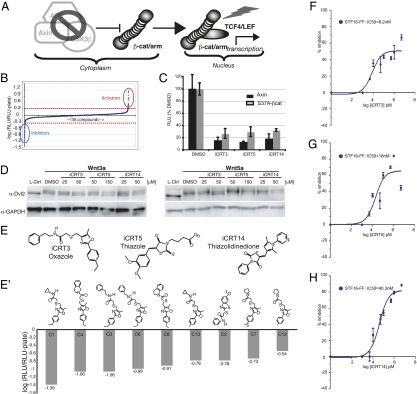Fig. 1.
(A) Primary screen. dsRNA-mediated knockdown of Axin results in cytoplasmic stabilization of β-cat, which, on translocation to the nucleus, results in activation of the β-cat responsive dTF12 reporter. (B) dTF12-luciferase activity in response to treatments with a small-molecule library, normalized to plate average, shows that, for all compounds screened, most had little or no effect on Wg signaling. Cut-off for cherry picking lead hits was set at ±0.3 on a logarithmic scale (red dashed line), reflecting either a twofold activation (red oval) or reduction (blue oval). The x axis represents the compounds screened, and the y axis represents the log transformation of the fold change of the dTF12 reporter for individual compounds over that of the plate average. (C) Reporter activity in Cl8 cells transfected with degradation-resistant β-cat is inhibited by candidate inhibitors to a similar extent as in cells transfected with dAxin dsRNA. (D) Western analysis of Dvl2 phosphorylation in Rat2 cells pretreated with iCRTs at the indicated doses and stimulated for 2 h with Wnt3a (Left) or Wnt5a (Right). The upper band, where present, is the phosphorylated form induced by noncanonical Wnt signaling. (E) Candidate inhibitors identified in the primary screen fall into three families: Oxazoles, Thiazoles, and Thiazolidinedione. (E′) Compounds belonging to the Oxazole family (like iCRT3 or C3), which were identified, in the primary screen as strong hits. The majority of them were also tested in secondary specificity and epistasis assays (Fig. S1 B and C). (F–H) Dose-response analysis of the Wnt responsive STF16-luc reporter in the presence of varying concentrations of iCRT3 (F), -5 (G), and -14 (H) in mammalian HEK293 cells.

